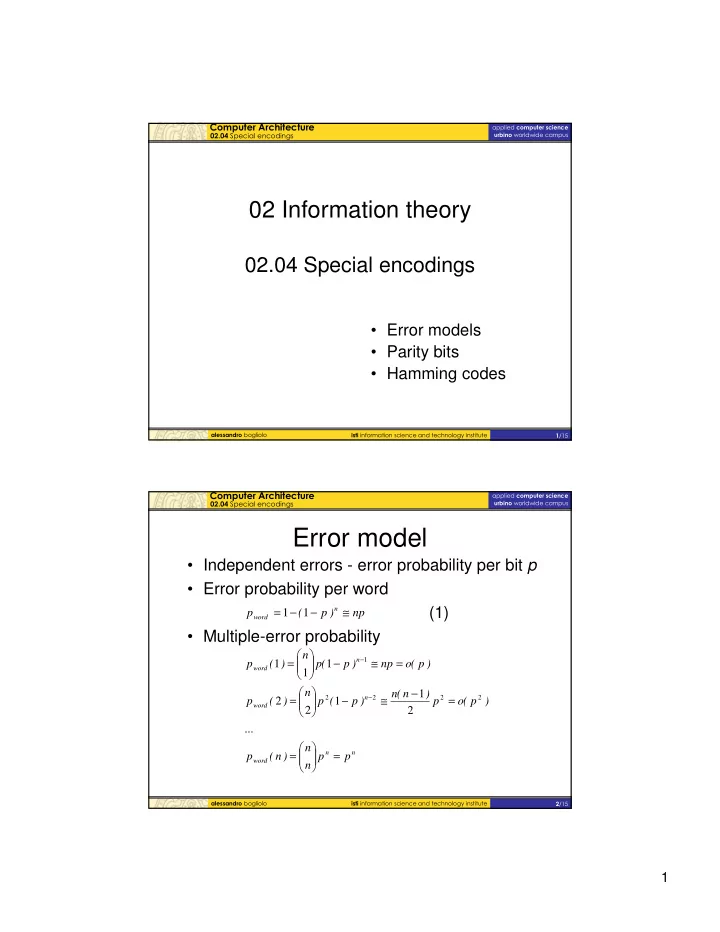

��������������������� �������� ���������������� ������ ����������������� ������ ���������������� 02 Information theory 02.04 Special encodings • Error models • Parity bits • Hamming codes ���������� �������� ���� �������������������������������������������� � ��� ��������������������� �������� ���������������� ������ ����������������� ������ ���������������� Error model • Independent errors - error probability per bit p • Error probability per word (1) n p = 1 − ( 1 − p ) ≅ np word • Multiple-error probability � � n � � n − 1 p ( 1 ) = � � p ( 1 − p ) ≅ np = o ( p ) word � 1 � � � n n ( n − 1 ) � � 2 n − 2 2 2 p ( 2 ) = � � p ( 1 − p ) ≅ p = o ( p ) word � � 2 2 ... � � n � � n n p ( n ) p p = � � = word � � n ���������� �������� ���� �������������������������������������������� � ��� 1
��������������������� �������� ���������������� ������ ����������������� ������ ���������������� Detection/correction target • Multiple errors are much less likely than single errors • The minimum target for error detection/correction are single errors per word • No encodings can detect/correct errors of any multiplicity ���������� �������� ���� �������������������������������������������� � ��� ��������������������� �������� ���������������� ������ ����������������� ������ ���������������� Hamming distance • Hamming distance between two words w1 and w2 d H ( w 1, w 2) • Hamming distance of a code: minimum Hamming distance between pairs of code words { } d ( code ) = min d ( w 1 , w 2 ) H H w 1 , w 2 ∈ code • Irredundant codes (using the minimum number of bits) have Hamming distance d H (code)=1 ���������� �������� ���� �������������������������������������������� � ��� 2
��������������������� �������� ���������������� ������ ����������������� ������ ���������������� Detection/correction requirements • If d H ( w 1, w 2)=1, a single error may transform w 1 in w 2 • If w 1 and w 2 belong to the same code, the error cannot be detected nor corrected, thus impairing reliability • The minimum Hamming distance required to detect up to e errors per word is d H (code)= e +1 • The minimum Hamming distance required to correct up to e errors per word is d H (code)=2 e +1 ���������� �������� ���� �������������������������������������������� � ��� ��������������������� �������� ���������������� ������ ����������������� ������ ���������������� Code classification • Error detecting codes ( e -EDC) – e errors transform any code word in a non-code word • Error correcting codes ( e -ECC) – e errors transform any code word in a non-code word that is closer to the original word than to any other code word • Any e- ECC is also 2e- EDC • Any code with d H > 1 is a redundant code • A n -bit redundant code is called separable if each codeword is composed of: – r information bits (belonging to an irredundant encoding) – m control bits (added to increase the Hamming distance between the codewords) n=r+m ���������� �������� ���� �������������������������������������������� � ��� 3
��������������������� �������� ���������������� ������ ����������������� ������ ���������������� Replication codes • Simple separable codes with the desired Hamming distance d H can be obtained by replicating d H times an irredundant code • Error detection technique – bit-wise comparison • Error correction technique – bit-wise majority voting n = d H r = r + ( d H -1) r m = ( d H -1) r ���������� �������� ���� �������������������������������������������� � ��� ��������������������� �������� ���������������� ������ ����������������� ������ ���������������� Parity codes • Parity bit : control bit computed in such a way that the codeword (or a subset of its bits) contains an even number of 1’s • Parity code : separable code obtained by adding parity control bits to an irredundant code • 1-EDC parity code: code with m =1 using a single parity bit computed over all the bits of the codeword • Correction technique: – Parity test of the number of 1’s in the word ���������� �������� ���� �������������������������������������������� � ��� 4
��������������������� �������� ���������������� ������ ����������������� ������ ���������������� Performance of parity code • Given: - p error probability per bit - L original length of a bit stream to be encoded - r size of a words (chunk of the bit stream) - We can compute: - p_c = 1- p complement of p - n = r+ 1 size of a codeword - P_w_correct = (1- p )^n - P_w_error = 1 -P_w_correct - P_w_ 1 error = n*p* (1 -p ) ^ ( n- 1) - P_w_ M error = P_w_error – P_w_ 1 error ���������� �������� ���� �������������������������������������������� � ��� ��������������������� �������� ���������������� ������ ����������������� ������ ���������������� Performance of parity code • We can also compute: - N_words 0 = L/r - N_reTx = P_w_ 1 error / (1 -P_w_ 1 error ) - N_words = N_words 0 * (1+ N_reTx ) - L_total = N_words * n - The value of r (chunk length) can be decided in order to optimize the performance of the code, expressed in terms of: - Overhead = L_total / L - 1 - Failure prob = P_w_Merror ���������� �������� ���� �������������������������������������������� �� ��� 5
Recommend
More recommend